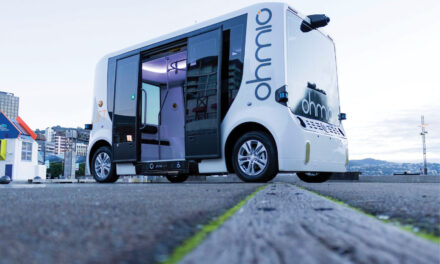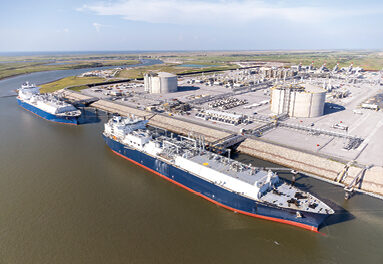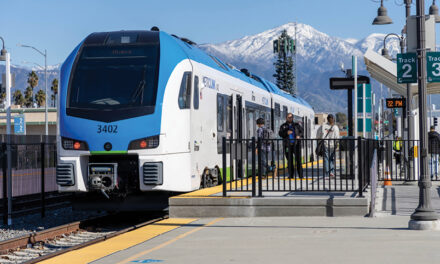Welcome to America’s Power Plant |
The energy infrastructure of Southwest Louisiana’s five ports fuels industrial growth.


By RON STARNER
Executive Vice President of Conway, Inc.
ron.starner@siteselection.com
The energy needed to power America requires a precise and predictable movement of goods and services through the nation’s ports. Nowhere in the country is that logistics network more critical, or more valuable, than the ports of Southwest Louisiana.
George Swift, president and CEO of the Southwest Louisiana Economic Development Alliance, calls the Southwest Louisiana Port Network “the energy corridor’s path to growth and success.”
Considering the magnitude of commerce that flows through these five ports daily, one can argue that, without these maritime facilities, much of the nation’s energy-dependent economy would shut down.
The Southwest Louisiana Port Network includes the Port of Lake Charles; the Cameron Parish Port, Harbor & Terminal District; the West Calcasieu Port; the Port of Vinton; and the Mermentau River Harbor & Terminal District. All are within a five-parish region of 300,000 people in southwestern Louisiana, bordering Texas and the Gulf of Mexico.
The five parishes of Allen, Beauregard, Calcasieu, Cameron and Jefferson Davis are home to these ports and the many industries they host. The City of Lake Charles serves as the commercial hub for the region and has 70,000 residents. About 250,000 people reside in the Lake Charles metropolitan area.
Most area residents owe their livelihood to the region’s waterways, its world-class transportation infrastructure, and the largest industrial gas pipeline network in the U.S. Together, they form the foundation of Louisiana’s energy-driven industrial economy.
Jim Rock, executive director of the Lake Area Industrial Alliance, puts it this way: “Last year, Southwest Louisiana exported almost two-thirds of all liquefied natural gas (LNG) in the country. We are the national leader in LNG exports with our port facilities. Due to our vast maritime infrastructure, we can ship in raw materials and then ship out finished products. That facilitates being able to ship products around the world.”
It also makes Southwest Louisiana the nation’s leader in industrial construction. “A little over $100 billion in existing, proposed and under-construction projects in the LNG sector are found in this region,” says Rock.
These include existing LNG operations for Cheniere (a $20 billion capital investment), Cameron LNG ($10 billion) and Venture Global Calcasieu Pass ($5.8 billion). Another $55.4 billion in LNG projects are proposed. That includes $13.5 billion at Venture Global; $15 billion at Tellurian; $10.9 billion at Lake Charles LNG; $8 billion at Commonwealth LNG; and $4 billion each at Cameron LNG and Cheniere LNG.

Most of these projects are located along the Calcasieu Ship Channel from Cameron to Lake Charles. If all announced LNG projects come to fruition, their combined shipping volume will increase by 143 million metric tons.
There are many reasons why these facilities choose to cluster near the Gulf of Mexico in Southwest Louisiana. The primary location factors include:
- A concentration of pipelines supplying cheap and abundant natural gas.
- Existing infrastructure for energy production and transportation.
- Deep-water shipping access and shallow-draft inland waterways.
- A skilled workforce trained to serve industrial needs.
- A community that welcomes and embraces industrial growth.
The ports are vital to the region’s economy. Combined, they generate up to 46% of the gross domestic product in the Lake Charles metro area. Nearly 40% of all materials processed in the metro area are done at port facilities; and more than 50,000 workers in Southwest Louisiana are employed in jobs tied directly to port activity.
To get a closer look at the economic impact of each port, we interviewed the directors of the five ports in the region.
Port of Lake Charles
The largest port in the region, the Port of Lake Charles is located 34 miles inland and is connected to the Gulf of Mexico by the Calcasieu Ship Channel, which is 40 feet deep and has a bottom width of 400 feet. The port’s main terminal covers over 200 acres. Approaching its centennial, the port ranks No. 13 in cargo volume in America and No. 7 in growth.
The port’s Industrial Park East facility is located next to Chennault International Airport and is one mile south of Interstate 10. A Louisiana Certified Site, the park covers 325 acres.
Port of Lake Charles Director Richert (Ricky) Self says that “not only does the U.S. depend on the Port of Lake Charles, but our allies depend on our LNG to use as a fuel source. We handle both petroleum coke and LNG; and we are an emerging pathway for wind power components.”
Hydrogen will be the port’s next major export, he says. “Hydrogen has really taken off in the last eight to 10 months,” says Self. “A lot of multinational companies have entered into agreements with us. They are interested in ammonia and hydrogen businesses.”
A surging U.S. economy, combined with rising global energy demand, is fueling a record run of business at the port. “We achieved revenue records in 2022 and 2023 and are on pace to do that again in 2024,” says Self. “2024 is expected to surpass 2023 by 8%. Tonnage is up too. We achieved record years in tonnage in 2022 and 2023. We will set another record this year.”
Raw materials are driving a lot of this surge, he adds. “In 2019, we handled 13,000 cubic meters of lumber. We did over 350,000 cubic meters of lumber in 2023, and we are projected to handle another 350,000 cubic meters this year. Home Depot, Lowe’s and Stine’s all do business here and source a lot of their lumber from our region.”
European shipping companies Norlat and Ultrabulk have had a lot to do with that, says Self. “They became our customers in 2019. They started by moving lumber. Now they are branching out into steel bars, pipe and wires. We attended the Breakbulk Europe trade show last year. It was a fruitful trip. We met with shippers and cargo owners. One payoff is more foreign direct investment at the Port of Lake Charles.”
Cement is another product on the rise. “Cement has gone from 78,000 tons in 2023 to what we project will be more than 500,000 tons in 2024,” says Self. “The ongoing construction of new LNG terminals in this area is driving that increase. We also anticipate a 20% increase in our volume of petroleum coke this year. That is a staple for both Citgo and Phillips 66, two large refineries operating in the region.”
And that’s just the starter, says Self. “We expect to announce several projects this year,” he adds. “A methanol plant was announced February 15th, 2024, as well as several ammonia projects. Shaw, which fabricates modules for the LNG plants, is in discussion with several LNG companies that want to expand here.”
Commercial tenant growth is accelerating port construction, he adds. “We signed an agreement on the largest single capital investment project in port history,” says Self. “Cajun Industries will rebuild several large facilities that were destroyed by Hurricane Laura. This will be a $133 million project to replace 25% of our covered storage and 33% of our berth space. That project is underway. A lot of our back-office-warehouse space was damaged by Laura. We are rebuilding seven warehouses that were destroyed — totaling 180,000 square feet.”
Finally, the port will add two new ship loaders in 2024. “One is nearly complete. It will arrive in March,” the director says. “It will be used to load petroleum coke for Citgo and Phillips 66. The second loader will arrive in 2025. It will also handle coke products.”
In short, Self says he expects clear skies and smooth sailing for the next nine months. “We have been on a great trajectory the last few years, and 2024 is looking to be another record year.”
Cameron Parish Port, Harbor & Terminal District
Home to three of the nation’s seven LNG plants and others under construction, the Cameron Parish Port, Harbor & Terminal District plays a vital role in keeping commerce churning throughout Southwest Louisiana. It has already earned a reputation as the LNG capital of the world, as it supplies the U.S. with 25% of its daily natural gas needs and exports gas to another 25 countries.
Kim Montie, executive director of the port, says that the port’s location at the mouth of the deep-water Calcasieu Ship Channel “makes it ideal for import and export business; and 44 miles of the Gulf Intracoastal Waterway within its jurisdiction position it strategically to feed the inland waterways of the nation as well.”

Cheniere Sabine Pass LNG is one of the largest ongoing capital investments in the country. Valued at $20 billion, this plant in Cameron Parish is expected to add significantly to the region’s export of LNG.
Photo courtesy of Cameron Parish Port
Major investment projects are in the works at Venture Global LNG CP2, Commonwealth LNG, Cameron LNG and Cheniere Sabine Pass LNG. In addition, the Bureau of Ocean Energy Management (BOEM) Gulf of Mexico wind lease is in federal waters 40 miles off the Cameron coast. In August 2023, this lease was awarded to RWE for $5.6 million. This new wind farm has the potential to support 2 gigawatts of offshore capacity — enough to power 435,400 homes. Other wind energy developers are looking at taking leases in these waters as well. For example, the Danish firm Vestas was granted 60,000 acres off Cameron Parish near Holly Beach.
Since 2016, the port has supported $33 billion of capital investment in the parish, according to Montie. Expansions in the parish have made the U.S. the top exporter of natural gas in the world, she adds.
West Calcasieu Port
More than 140 barges are fleeted daily at West Calcasieu Port, located two miles west of the Calcasieu Ship Channel on the Gulf Intracoastal Waterway. Primarily a marine services installation, WCP is home to dry-barge cleaning, diesel engine repair, and wet-barge stripping and cleaning services.
WCP offers 190 acres of usable land. That includes 2,500 linear feet of waterfront and a 12-foot depth. Shipments making runs from Texas to Florida frequently stop at WCP.
Lynn Hohensee, port director at WCP, says the primary tenants are firms that provide services like barge fleeting. “VLF Marine Services provides maintenance, cleaning and repair work to wet barges,” he says. “These barges carry products geared to wet chemicals and petrochemical products. River Barge Works services dry barges — mostly copper barges that carry aggregate, petroleum coke, grain and other assorted products. Devall Southern LLC services marine diesel engines used by push boats in the barge towing industry. That is the niche of our port. We fit very well into the family of ports in Southwest Louisiana.”
Business and assets at the port are growing too, notes Hohensee. Total assets at the port climbed from $2.95 million in 2007 to $22.61 million in 2023. Meanwhile, annual operating increased from $128,287 in 2007 to $411,612 in 2020.

He adds that “around 90% of our revenue goes back into infrastructure improvements or expansion of our infrastructure. We do not have to provide funding for a staff. We have very little overhead. We are very lean.”
Hohensee wants prospective tenants to know that “we have a shovel-ready site that is prepared for development. We applied for a grant following Hurricane Harvey. We were awarded $4.3 million to assist with building a bulkhead crane pad. We are a one-stop shop for the intracoastal marine industry. That is what we bring to the table. If that is your niche, we just might be the right place for your business.”
Port of Vinton
Located on the Vinton Navigation Channel, the Port of Vinton is a shallow-water facility with more than 850 acres of developable, industrial-zoned port property near the Gulf Intracoastal Waterway and Interstate 10 close to the Texas-Louisiana border.
“We have two tenants: Dunham Price Group, which has 130 employees and makes concrete products, and Performance Blasting, which has seven,” says Jerry Merchant, port director. “We have one piece of property of 156 acres that is certified by the state and ready for development. Other properties at the port are being certified. Several people are looking at properties for long-term leases.”
The port accommodates barge traffic with its 12-foot water depth. “DP makes the concrete columns that go underground beneath the large LNG terminals,” says Merchant. “They also make I-beams for overpasses. Their products ship out by barge and truck. PB is a blasting and paint plant for industrial pipe components. Fabricated pipe is shipped in to PB, where it is sandblasted and painted before being shipped back to customers.”
Located 42 miles from the Gulf of Mexico, the Port of Vinton has Sabine River and Sabine Lake to the west and the Calcasieu Ship Channel to the east. “Our properties are zoned for heavy industrial use. We have all the essential utilities on site: water, sewer, natural gas and electrical power. Our properties are good for any type of fabrication, petrochemical manufacturing, warehouses and distribution centers,” says Merchant. “Just about anything you need can be found or done here.”
Mermentau River Harbor & Terminal District
A small but emerging port located along the Mermentau River, the Mermentau River Harbor & Terminal District handles 62,000 tons of cargo annually. Inbound cargo includes aggregate, fertilizer and rough rice. Outbound cargo includes rice, soybeans and rice hull compost. A shallow-water port with a draft of 9 feet, it is located one mile north of U.S. Highway 90.
The Mermentau flows south into Lake Arthur and connects with the Gulf Intracoastal Waterway and the Gulf of Mexico.
“Our tenants include Port Aggregates and Helena Chemical Company,” says Stephen Broussard, port director. “Helena is a fertilizer producer for the farm industry. They supply farmers who grow rice and soybeans in our region. The Mermentau flows all the way from Acadia Parish through Jefferson Davis Parish and then eventually into Lake Arthur and the Gulf.”
With water being the cheapest form of transportation, Broussard notes that “this is the cheapest way to get materials to farmers. “We can accommodate whatever barge activity that someone needs with the water depths that we have.”
This Investment Profile was prepared under the auspices of the Southwest Louisiana Economic Development Alliance. For more information, visit www.allianceswla.org.






